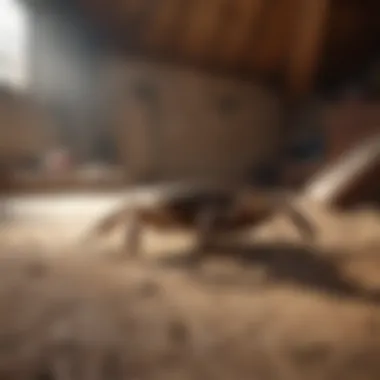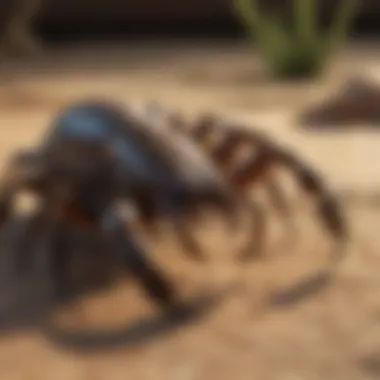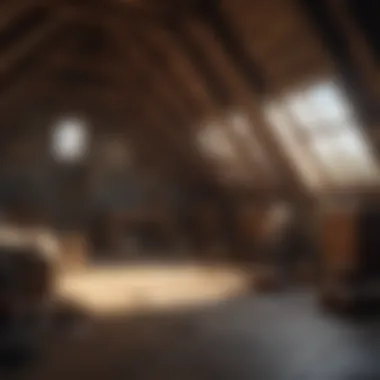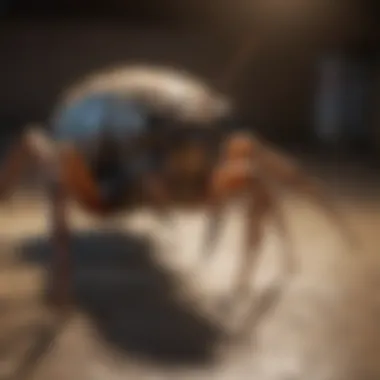Understanding Scorpion Presence in Attics


Intro
Scorpions are arachnids that evoke intrigue and concern in equal measure. Their presence in attics specifically poses a unique challenge. Understanding why they inhabit these spaces can help homeowners mitigate associated risks effectively. This article will delve into the factors contributing to scorpion infestations, risks involved, identification techniques, and measures for prevention and control.
Pest Identification
Common Household Pests
Within attics, scorpions are often mistaken for other pests. Some common household pests include spiders, centipedes, and various insects. Identifying scorpions is crucial for effective management. They can be distinguished by their elongated bodies, pincers, and a stinger at the end of their tails. Notably, the Arizona bark scorpion is one of the most common species found in attics, known for its venomous sting.
Signs of Infestation
To detect the presence of scorpions, look for:
- Webs or shed skin: Scorpions may leave behind webs or molted exoskeletons.
- Droppings: Scorpion droppings can resemble small dark pellets.
- Live sightings: Finding them, especially during the night when they are more active, is a clear sign.
- Other pest activities: A high presence of insects in the attic may attract scorpions, as they are predator species.
Scorpions seek dark, undisturbed areas, making attics an inviting environment for them.
Prevention Methods
Environmental Modifications
Homeowners can take several steps to reduce the likelihood of scorpions taking residence in their attics. Such modifications include:
- Sealing cracks: Inspect and seal gaps around windows and doors.
- Removing clutter: Keep attics tidy to eliminate hiding spots.
- Controlling humidity: Ensure proper ventilation to reduce moisture, which attracts other pests.
Home Maintenance Tips
Regular maintenance helps create an unfavorable environment for scorpions. Focus on:
- Inspecting the roof: Ensure that shingles are intact to prevent gaps.
- Trimming vegetation: Cut back any plants or branches that touch the house, as they provide easy access for scorpions.
- Examine lighting: Use yellow-light bulbs outside to decrease the attraction of insects, a potential food source for scorpions.
DIY Pest Control Solutions
Natural Remedies
For those who prefer to avoid chemical treatments, there are effective natural remedies, including:
- Diatomaceous earth: This powder can be sprinkled in areas where scorpions are suspected.
- Essential oils: Some oils like peppermint and cedar can repel scorpions when used in a diluted spray.
DIY Traps and Barriers
Setting traps can help monitor and control scorpion activity. Consider using:
- Sticky traps: Place around the attic to catch wandering scorpions.
- Homemade barriers: A mixture of soap and water can create a barrier that makes it challenging for scorpions to cross.
Foreword to Scorpions
Scorpions have fascinated and terrified humans for centuries. Their unique biological traits and mysterious behavior position them as one of nature's more intriguing arachnids. Understanding these creatures becomes essential for homeowners who might find them in their attics. This section sets the groundwork for a deepened awareness of scorpions, providing critical information that will help readers grasp their role in the ecosystem and their impact on our living spaces.
Biological Classification
Scorpions belong to the class Arachnida, which includes spiders, mites, and ticks. Within this class, they fall under the order Scorpiones. Scorpions can be found on every continent except Antarctica, indicating an adaptability to diverse environments. The two primary families of scorpions are the Buthidae and the Scorpionidae, with numerous genera and species within each family. By understanding their classification, one can appreciate their evolutionary traits and specific behaviors, shedding light on their ecological importance.
Physical Characteristics
Scorpions are characterized by their distinct morphology. They typically have a pair of pincers (chelae), a segmented tail, and four pairs of legs. Their body length can vary significantly among species, ranging from a few centimeters to over 20 centimeters. The tail is particularly interesting; it often curls over the back and contains a venomous stinger. This stinger is used for hunting and self-defense. The appearance of scorpions can vary by species, but most exhibit a hard exoskeleton that can be opaque or a mix of colors, providing either camouflage or warning signals to potential predators.
Behavioral Traits
Scorpion behavior is largely based on their environment and hunting strategies. They are nocturnal creatures, primarily active during the night when they hunt for prey. Common prey includes insects like crickets and beetles. Scorpions use their pincers to capture prey and then inject venom through their stinger to subdue it. Additionally, scorpions have unique communication methods; they use pheromones to attract mates and other vibrations to signal danger or establish territory. Understanding these behaviors aids homeowners in recognizing potential risks and knowing how to address them.
"Knowledge of scorpion behavior can inform prevention strategies, potentially keeping your home safe from these arachnids."


Why Scorpions Enter Attics
Scorpions are often associated with arid environments. Surprisingly, one of their less obvious habitats is within attics. Understanding the reasons behind scorpions entering attics can assist homeowners in devising strategies to address this issue. This section will detail some of the primary motivations that drive scorpions towards such spaces, including their need for shelter, their association with prey, and favorable environmental conditions.
Search for Shelter
Scorpions require refuge from heat and predators. An attic provides an ideal space for this need. The elevated position of an attic also offers protection from larger animals and human activity, making it an attractive choice. During hot seasons, temperatures can soar outside, prompting scorpions to seek cooler environments. An attic serves both as a cooler refuge and as a relatively secluded area, allowing scorpions to escape extreme weather conditions.
- Space: Attics often have nooks and crannies, offering spots for scorpions to hide.
- Protection: The insulated nature of attics can help maintain a more stable temperature compared to outside, making it favorable for scorpions.
Affiliation with Prey
Another reason scorpions might venture into attics is the presence of prey. Attics can often be home to various insects and rodents, which serve as food sources for scorpions. This relationship is cyclical; when there are more insects or small animals in the attic, scorpions follow. Unexpectedly, they might find their way into human living spaces as they seek a reliable food supply.
- Insects: Common household pests such as crickets and cockroaches can attract scorpions to an attic.
- Rodents: If mice are present, scorpions may be drawn in due to the potential food source, leading to increased scorpion activity in these spaces.
Environmental Conditions
The environmental dynamics surrounding a home play a significant role in scorpion behavior. Specific conditions such as humidity, temperature, and the availability of food contribute heavily to their movement.
- Humidity levels: Scorpions are sensitive to humidity and prefer areas that offer some moisture, making attics appealing during dry summer months.
- Structural aspects: Cracks in walls or openings around vents contribute to enabling scorpions to enter attics.
Understanding these environmental conditions is crucial for mitigating scorpion presence in attics.
In summary, scorpions are drawn to attics primarily due to the shelter they offer, their association with potential food sources, and the favorable environmental conditions. Awareness of these factors is essential for effectively addressing scorpion infestations.
Identification of Scorpions
Understanding the identification of scorpions is crucial for homeowners, as it helps to recognize the presence and extent of infestations. Different species of scorpions vary in their habits, habitats, and the level of threat they pose. Acknowledging the specific types present can inform appropriate methods for control and prevention. Additionally, effective identification can help in differentiating scorpions from other similar arachnids, reducing unnecessary panic or missteps in dealing with these creatures. This section focuses on common species, distinguishing features, and signs of infestation.
Common Species Found in Attics
Several species of scorpions may inhabit attics, depending on the geographical location. In the United States, the Arizona bark scorpion is known for its venomous sting. This species thrives in warmer climates and can often be found hiding in attics, seeking cooler areas during the heat. Another example is the striped-tailed scorpion, which exhibits less aggression and poses a lower threat, though caution is still necessary.
These common species exhibit different colors, sizes, and behaviors that are significant when identifying them. Recognizing their presence is the first step in managing any potential risk they might pose to a home.
Identifying Features
Identifying features of scorpions include body shape, coloration, and size. Most scorpions are characterized by their segmented bodies, eight legs, and pincers. The body structure generally includes a cephalothorax and abdomen. For example, many scorpions have a slender, elongated shape and can range from about 2 to 8 inches long, depending on the species.
Color can also be a key identifying feature. Many scorpions are yellow or brown, which allows them to blend into their surroundings. The presence of fluorescent qualities under ultraviolet light can help in locating them in dark spaces as well. Additionally, the tail's curving shape, often with a stinger at the end, provides visual cues that aid identification.
Signs of Infestation
Signs of a scorpion infestation can vary, but there are specific indicators that homeowners should watch for. These include:
- Presence of shed exoskeletons: Scorpions molt several times in their lifetime.
- Pincer marks or residue: They often leave behind holes or debris in the environment they occupy.
- Sightings: Observing scorpions in common areas like attics or basements is a clear sign of their presence.
Other indicators include finding food remnants, such as insects, which may suggest a food source for the scorpions. Remember, confirming an infestation early can lead to more effective measures to mitigate risks associated with scorpions.
Potential Risks of Scorpions in the Attic
Scorpions may appear small and harmless, but their presence in an attic can pose significant risks to both health and property. The potential dangers can affect homeowners mentally and physically, and addressing these concerns is crucial. Understanding the impact of scorpions can help homeowners take necessary precautions.
Health Risks
Scorpions are known for their venomous stings. While not all species are fatal to humans, the sting of certain types can cause severe pain, swelling, and other serious reactions. Individuals with allergies or compromised immune systems may experience more severe symptoms, which can lead to hospitalization. Furthermore, the fear of finding a scorpion can lead to anxiety and distress among family members, particularly children.
This makes awareness about local scorpion species essential. For example, the Arizona bark scorpion is one of the most venomous and is commonly found in attics. Individuals who are allergic should seek immediate medical attention following a sting.
"Education and awareness can literally save lives when it comes to potentially dangerous scorpions."
Structural Damage
Scorpions do not directly harm the structural integrity of a home in the way termites do. However, their presence can indicate other concerns. If scorpions are found, it may point to a larger issue with pests in the attic that can cause structural damage. This could include rodents or insects that contribute to materials degrading over time. Moreover, in their search for a suitable nesting spot, scorpions can invade the insulation and attract more pests, creating a larger infestation problem. Monitoring is key, as ignoring these signs could lead to bigger issues and costly repairs down the road.


Impact on Property Value
The presence of scorpions can directly impact property value. Homebuyers are less likely to choose a property that has had a history of scorpion infestations. The report of potential health risks, combined with the fear of structural damage, can create a stigma around the home. This stigma leads to decreased buyer interest or significant price reductions during negotiations. Homeowners may need to invest more in pest control solutions to combat their presence, which adds to the overall cost.
Awareness and communication when selling a house are critical. If an infestation has been resolved, ensuring documentation of pest control services can help alleviate buyer concerns.
Preventive Measures for Homeowners
Preventive measures are essential in managing the presence of scorpions in attics. Implementing effective strategies not only reduces the likelihood of infestation but also minimizes health risks associated with these arachnids. This section highlights specific actions homeowners can take to secure their living spaces. By understanding the significance of preventive measures, homeowners can protect their property and improve their overall safety and comfort in their homes.
Sealing Entry Points
Sealing entry points is a fundamental step in preventing scorpions from accessing the attic. Scorpions can enter through very small openings, such as gaps around windows, doors, and vents. Therefore, it is crucial to inspect the exterior of the home regularly. Homeowners should use silicone caulk to fill gaps or cracks and consider installing door sweeps on exterior doors. Additionally, screens for vents can help in blocking access.
Here are key points to consider:
- Check for cracks in the foundation and walls.
- Secure any holes in the roof or eaves.
- Use sturdy materials that can withstand weathering.
By sealing entry points systematically, homeowners can greatly reduce the chance of scorpions finding harbor in their attics.
Maintaining a Clean Environment
A clean environment is less appealing for scorpions and other pests. Regular cleaning effectively eliminates food sources and hiding spots, which are attractive to scorpions. Homeowners should declutter the attic and remove debris, such as cardboard boxes and old furniture.
Moreover, keeping the outdoor surroundings tidy can deter scorpions from approaching the house. This includes:
- Removing debris, such as piles of leaves or stones.
- Maintaining vegetation and keeping plants trimmed back from the home.
- Ensuring that outdoor lighting does not attract insects, as scorpions often follow them.
These measures will help create an environment that is less conducive to scorpions.
Regular Inspections
Regular inspections are a proactive approach in managing scorpion risk. Homeowners should frequently inspect their attics for any signs of scorpion presence or possible entry points. Observing for actual sightings or exoskeletons can provide crucial insights about an infestation.
The following should be part of a regular inspection routine:
- Check for droppings or webs, indicators of an infestation.
- Look closely at corners, crevices, and dark hiding places where scorpions may thrive.
- Consider monitoring using sticky traps to catch any wandering scorpions.
By implementing a routine inspection schedule, homeowners can catch potential issues early, preventing more extensive problems later on.
Eco-Friendly Pest Control
Eco-friendly pest control has emerged as a significant consideration when addressing the presence of scorpions in attics. This approach prioritizes methods that are less harmful to the environment and potential inhabitants of the home. Utilizing eco-friendly strategies not only helps to manage scorpion populations but also aligns with sustainable living principles. This section will delve into various eco-friendly solutions, emphasizing their effectiveness, safety, and practicality for homeowners.
Natural Repellents
Natural repellents are an effective first line of defense against scorpions. These substances can deter scorpions without harmful chemicals. One common natural repellent includes essential oils, such as peppermint or lavender oil. Spraying these oils around entry points can create an unfriendly environment for scorpions. Other options include vinegar and citrus-based solutions.
- Peppermint Oil: Mix with water and spray in areas where scorpions may enter.
- Citrus Spray: Scorpions are averse to citrus, making it another great option.
It is crucial to apply these natural repellents regularly to maintain their effectiveness. Homeowners should also note that while they may not eliminate scorpions entirely, these repellents can significantly reduce their prevalence in attics.
Habitat Modification
Habitat modification involves making adjustments to the environment that discourage scorpions from nesting in attics. This strategy can significantly minimize future infestations. Homeowners can start by removing any clutter in attics, such as boxes or unused furniture where scorpions may hide. Additionally, trimming nearby trees and bushes can further deter scorpions from accessing the roof.
- Seal Entry Points: Close gaps and cracks in walls and roofs to prevent scorpions from entering.
- Remove Attractants: Ensure that food and water sources, even in small amounts, are eliminated to reduce scorpion attraction.
By modifying the habitat, homeowners can create an environment that is less inviting to scorpions while promoting overall cleanliness and order in the attic space.
Integrated Pest Management
Integrated pest management (IPM) is a holistic approach combining various strategies for effective pest control. This plan incorporates the use of eco-friendly practices tailored to manage scorpion populations effectively. Educating oneself on scorpion behavior, lifecycle, and preferred habitats is crucial for successful implementation of IPM.


Key components of IPM include:
- Monitoring: Regularly check attics for signs of scorpions and take note of their activity levels.
- Identification: Understand the scorpion species present to tailor strategies effectively.
- Combination of Methods: Use natural repellents alongside habitat modification to enhance control efforts.
IPM not only helps in managing scorpions but also encourages sustainable practices, thus maintaining harmony between living spaces and local ecosystems.
"Embracing eco-friendly pest control measures offers effective solutions to manage scorpion populations while supporting environmental sustainability."
Homeowners who adopt these eco-friendly pest control methods can contribute to a healthier living environment, reducing reliance on traditional chemicals and fostering a sense of responsibility towards their immediate surroundings.
Professional Pest Control Services
The presence of scorpions in attics can pose various challenges for homeowners. This is where professional pest control services become crucial. They offer specialized expertise and tools that most homeowners lack. Understanding when and how to engage these services can lead to better management of scorpion infestations.
When to Seek Help
Recognizing the signs of a scorpion problem is vital. If you notice multiple sightings of scorpions or find dead ones, it may be time to call a professional.
In addition, if you have children or pets, it is especially important to take swift action. An experienced pest control service can help assess the situation and determine the severity of the infestation. Prompt intervention can prevent potential stings, which may have serious health implications.
Evaluating Pest Control Companies
Not all pest control companies are created equal. When choosing a service, consider the following factors:
- Experience: Look for companies with a good record in handling scorpions.
- Reviews: Online reviews from previous customers can provide insight into their effectiveness.
- Certifications: Verify that the technicians are certified and trained in pest control methods.
- Techniques Used: Inquire about their approach to control and treatment, especially concerning eco-friendly options.
Comparing multiple companies helps ensure that you select a provider who will address your concerns effectively and ethically.
Expected Treatment Options
When hiring pest control companies, they typically offer a range of treatment options:
- Chemical Treatments: Effective but should be used with caution, especially in homes with children and pets.
- Baiting Systems: These can be less intrusive and target scorpions' habitats directly.
- Integrated Pest Management: This is a holistic approach that combines monitoring, prevention, and treatment.
- Exclusion Techniques: Closing off entry points and making environmental adjustments can reduce the risk of future infestations.
Using a variety of methods can maximize effectiveness and ensure long-term control of scorpions in your attic.
Monitoring and Follow-Up
Monitoring and follow-up are crucial components in the effective management of scorpions in attics. Once a scorpion infestation is identified, it is essential to keep track of their activity and assess the effectiveness of chosen control measures. This ongoing process helps to ensure that preventive actions remain relevant and responsive to changes in the environment. Additionally, follow-up monitoring can reveal new infestations before they escalate.
Tracking Scorpion Activity
Tracking scorpion activity involves observing scorpion behavior in and around the attic. Homeowners should regularly check for the presence of scorpions, their tracks, or webs. This can be done using simple tools such as; flashlights to inspect dark corners or traps specifically designed to capture scorpions. By marking the areas where scorpions are seen most often, patterns of movement can be noted.
Useful techniques for tracking include:
- Daily checks: Perform inspections daily, especially during warmer months when scorpion activity peaks.
- Temperature observations: Scorpions tend to be more active during specific temperatures. Knowing when they are likely to emerge can help schedule monitoring efforts effectively.
- Regular trap monitoring: Position traps at strategic locations and evaluate them frequently to gauge scorpion population density.
Adjusting Strategies Based on Observations
Adjusting strategies based on the collected observations is fundamental in pest control. If tracking reveals an increase in scorpion sightings, it may be time to rethink your current approach. For example, if traps are filling up quickly, this indicates a significant population that may require more aggressive control measures.
Considerations for adjustments may include:
- Re-evaluating pest barriers: If scorpions are still getting inside despite sealing efforts, a further assessment of doors, vents, and other potential entry points is necessary to improve sealing methods.
- Change in pest control methods: Homeowners may find that certain eco-friendly methods are less effective for their specific situation. Researching alternative solutions, such as different natural repellents, should be considered.
- Scheduling more frequent inspections: If scorpion activity remains high, increasing the frequency of inspections can help in managing the issue proactively.
Effective monitoring and response will mitigate the risks posed by scorpions, ensuring a safer living environment for you and your family.
Epilogue
Summary of Key Points
In summary, several critical points emerged throughout this article. Firstly, __________ scorpions typically enter attics for shelter, prey, and suitable environmental conditions. Identifying the common species and their characteristics helps in recognizing possible infestations early. Secondly, the risks associated with scorpions, such as health hazards and damage to property, emphasize the need for prompt action. Thirdly, this article covered effective preventive measures homeowners can take, including sealing entry points and maintaining cleanliness. Finally, eco-friendly pest control strategies provide sustainable alternatives for managing scorpion populations without harming the environment.
Final Recommendations
To protect your home from scorpions, consider implementing the following recommendations:
- Regular inspections of attics and surrounding areas can help detect scorpions early.
- Sealing entry points is essential to prevent scorpions from entering.
- Adopt natural repellents such as citrus or vinegar to deter scorpions without toxic chemicals.
- When needed, seek assistance from professional pest control services to ensure thorough treatment, especially for significant infestations.
By taking these measures, homeowners can safeguard their living spaces from the adverse effects of scorpions.















